Irish Writing and Writing Materials
From A Smaller Social History of Ancient Ireland 1906
« previous page | contents | start of chapter | next page »
CHAPTER VIII....continued
2. Writing and Writing Materials.
Scribes.—After the time of St. Patrick, as everything seems to have been written down that was considered worth preserving, manuscripts accumulated in the course of time, which were kept in monasteries and in the houses of hereditary professors of learning: many also in the libraries of private persons. As there were no printed books, readers had to depend for a supply entirely on manuscript copies. To copy a book was justly considered a very meritorious work, and in the highest degree so if it was a part of the Holy Scriptures, or of any other book on sacred or devotional subjects, Scribes or copyists were therefore much honoured. The handwriting of these old documents is remarkable for its beauty, its plainness, and its perfect uniformity, each scribe, however, having his own characteristic form and style.
Vellum.—Two chief materials were used in Ireland for writing on:—Long, thin, smooth rectangular boards or tablets; and vellum or parchment, made from the skins of sheep, goats, or calves, which was the most usual and the most important material. Inscriptions were also carved on stone, both in ordinary Irish letters and in Ogham. The scribes had to make all their own materials—tablets, vellum, ink, and pens.
Ink (Irish dub or dubh, i.e. 'black': pron. dhuv). The ink was made from carbon, without iron or any other mineral, as is shown by delicate chemical analysis. In the more ancient MSS., a thick kind of ink was used, remarkable for its intense blackness and durability: and its excellence is proved by the fact that in most of the very old books the writing is almost or altogether as black as it was when written, more than a thousand years ago. The ink was kept in a little vessel commonly made of part of a cow's horn, and therefore called adarcin or adircin [ey-arkeen], meaning 'little horn,' from adarc [ey-ark], 'a horn.'
Pen.—The pens were made from the quills of geese, swans, crows, and other birds: no metallic pens were used. In some figures of the evangelists drawn in MSS. of the eighth century, the pens with their feathers, and the penknife with which they were cut, are quite plain to be seen.
Wooden Tablets.—The other materials for writing on were long, narrow, smooth, wooden slits, called by various names:—Taibhli filidh [tav'ila-filla], 'tablets of the poets'; and tabhall lorga, 'tablet staves' (lorg, 'a staff'). On these the letters were either written in ink or cut with a knife. The staves were generally tied up in a bundle, so as to be carried conveniently. The use of tablets for writing on was not peculiar to the Irish: for it is well known that, before parchment came into general use, the Romans, the Jews, and other ancient nations inscribed their laws, poems, &c., on wooden tablets.
FIG. 59. From an illuminated manuscript copy of Giraldus Cambrensis, written about A.D. 1200: now in British Museum. Underneath is the iscription—'The Scribe writing the Marvellous Kildare Gospels.' Photographed from reproduction in Gilbert's Facsim. Nat MSS., and reproduced here from the photograph.
The writing-tablets used by ecclesiastics, which must have been similar to the poets' tablets, were commonly known by the name of pólaire (3-syll.), a term used collectively to denote a number of single staves. Sometimes they were written on with ink; but more commonly the surface was covered with wax, which was written on with a metallic style. Waxed tablets were used for temporary purposes, such as taking notes of a sermon, or other such memorandums: when the purpose was served, the wax was smoothed to be written on again. They were employed also by schoolmasters in old times for teaching their scholars the elements of reading. Adamnan, in the seventh century, mentions that he inscribed certain writings at first (temporarily) on waxed tablets, and afterwards on vellum. All literary matter intended to be permanent was written on vellum or parchment. The use of waxed tablets continued till the seventeenth century.
Style.—When writing on a waxed tablet, they used a graib or graif, i.e. graphium, a sharp-pointed style of metal, which, when not in use, was commonly kept fastened in a loop or flap fixed on the sleeve or on the front of the cloak. When St. Patrick was in the act of destroying the idol, Cromm Cruach, his graif fell out of his mantle into the heather, where he had some difficulty in finding it afterwards.

